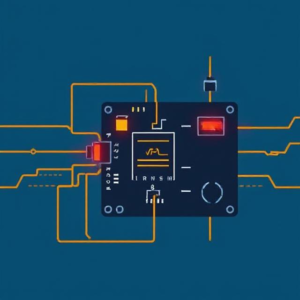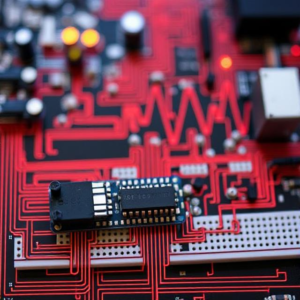What is Signal Isolation?
Signal isolation is a technique used to prevent electrical interference or unwanted current from passing between different parts of an electronic system. It’s like creating a “barrier” that lets signals travel but keeps harmful electrical noise, spikes, or faults from reaching sensitive parts of the system.
This is important because different parts of an electronic system (like a computer, sensor, or power supply) may run on different voltage levels, or there could be high voltages that could damage sensitive components. Signal isolation helps keep everything working safely and smoothly.

Why Do We Need Signal Isolation?
- Protecting Sensitive Components: Some parts of a system, like microcontrollers or sensors, are very sensitive to high voltages. Signal isolation keeps these parts safe from dangerous spikes or surges.
- Reducing Noise: Electrical noise can come from things like motors, power supplies, or other equipment in the system. Noise can interfere with the signals, causing errors. Isolation helps keep the clean signals separate from noisy ones.
- Preventing Ground Loops: Sometimes, different parts of a system can have slightly different ground voltages, which can cause unwanted currents to flow between them. Signal isolation prevents this from happening.
- Safety: Signal isolation is crucial in high-voltage environments (like industrial settings) to prevent dangerous electrical faults from passing into low-voltage areas, protecting both the equipment and the people working with it.
Common Signal Isolation Techniques
There are several ways to isolate signals, each with its own advantages. Let’s look at the most common ones:
1. Optocouplers (Optoisolators)
- How They Work: Optocouplers use light to transfer a signal between two circuits while electrically isolating them. They consist of an LED (Light Emitting Diode) on one side and a photosensitive element (like a photodiode or phototransistor) on the other side, all inside a single package.
- What Happens: When a signal is sent to the LED, it lights up and the light is detected by the photosensitive element, which then sends the signal to the second side of the circuit. Since light is used, there is no direct electrical connection between the two parts.
- Why Use Them: Optocouplers are great for isolating signals in systems that need to control things like motors or high-voltage systems. They’re used in things like microcontroller interfaces and AC to DC converters.
2. Transformers
- How They Work: Transformers are electrical devices that use magnetic fields to transfer power or signals between two circuits, while keeping them electrically isolated.
- What Happens: A transformer has two coils of wire: the primary coil and the secondary coil. When an alternating current (AC) signal flows through the primary coil, it generates a magnetic field that induces a voltage in the secondary coil. Since the coils aren’t physically connected, there is no direct electrical path between the circuits.
- Why Use Them: Transformers are commonly used in power supplies, where they can convert AC from high voltage to low voltage or vice versa. They’re also used in signal processing, like in audio systems, to prevent ground loops.
3. Capacitive Coupling
- How It Works: In capacitive coupling, signals are transferred through a capacitor instead of a direct wire connection. Capacitors allow AC signals to pass through but block DC signals, which helps isolate parts of the circuit.
- What Happens: The capacitor “blocks” any DC voltage or current from passing from one side to the other, but AC signals (which are used in many types of communication) can pass through, allowing the signal to be transferred while maintaining isolation.
- Why Use It: Capacitive coupling is used in high-frequency circuits like audio equipment or data communication systems to prevent unwanted DC voltages from interfering.
4. Galvanic Isolation
- How It Works: Galvanic isolation is a technique where electrical isolation is achieved by preventing direct electrical contact between two circuits, often using components like optocouplers or transformers.
- What Happens: The idea is that even if one circuit experiences a voltage spike or fault, it won’t affect the other circuit because they are electrically isolated. This method is commonly used in power supplies and sensitive measurement equipment.
- Why Use It: This method is important in situations where the electrical systems need to be isolated for safety or to prevent ground loops.
5. Relays (Electromechanical Isolation)
- How They Work: A relay is an electromechanical device that uses an electrical signal to control a switch. The control signal activates an electromagnet inside the relay, which then opens or closes a set of contacts, completing or breaking the circuit.
- What Happens: The relay can switch high-power circuits using low-power signals, and because of the physical separation between the contacts, it provides isolation between the two circuits.
- Why Use It: Relays are often used in industrial control systems and automated systems where low-voltage electronics need to control high-voltage equipment, like motors or lights.
Examples of Where Signal Isolation Is Used
- Industrial Control Systems: To protect sensitive electronics from noisy or high-voltage systems like motors or heavy machinery.
- Medical Equipment: To ensure that high-voltage circuits (like those used for imaging) don’t interfere with low-voltage circuits in patient monitoring systems.
- Audio Systems: To prevent ground loops that can cause noise or hum in the sound system.
- Power Supplies: To convert high-voltage AC power into lower-voltage DC power while keeping the high-voltage side electrically isolated from the low-voltage side.
- Microcontroller Communication: In situations where microcontrollers need to communicate with high-voltage equipment safely.
Why is Signal Isolation Important?
- Prevents Damage: It keeps sensitive components safe from high voltage, spikes, or surges that could burn out the electronics.
- Improves Performance: Reduces electrical noise or interference that could corrupt the signal or cause errors.
- Safety: It isolates dangerous high-voltage systems from low-voltage systems, preventing accidents or electrical shocks.
- Ground Loop Elimination: Helps eliminate problems caused by differing ground voltages between systems, which can create unwanted currents or noise.
Summary:
Signal isolation techniques help protect electronics from electrical noise, high voltage, and other unwanted signals. Common methods include optocouplers, transformers, capacitive coupling, galvanic isolation, and relays. These techniques are used in everything from industrial control systems to audio equipment, ensuring safety, performance, and reliability in electrical systems.











